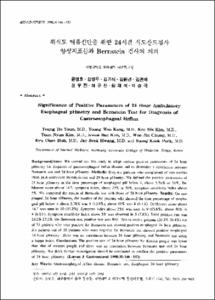KUMEL Repository
1. Journal Papers (연구논문)
1. School of Medicine (의과대학)
Dept. of Internal Medicine (내과학)
위식도 역류진단을 위한 24시간 식도산도검사 양성지표들과 Bernstein 검사의 의의
- Keimyung Author(s)
- Kim, Kwon Bae; Kim, Yoon Nyun; Chung, Woo Jin; Hwang, Jae Seok; Park, Soong Kook; Kang, Young Woo; Kim, Kee Sik
- Department
- Dept. of Internal Medicine (내과학)
- Journal Title
- Korean Journal of Gastroenterology
- Issued Date
- 1998
- Volume
- 31
- Issue
- 2
- Abstract
- Background/Aims: We carried out this study to adapt various positive parameters of 24 hour pHmetry for diagnosis of gastroesophageal reflux disease and to determine a correlation between Bernstein test and 24 hour pHmetry. Methods: Sixty-six patients who complained of non-cardiac chest pain underwent Bernstein test and 24 hour pHrnetry. We defined the positive parameters of 24 hour pHmetry as the time percentage of esophageal pH below 4, above 5.78% or 11%, DeMeester score ahove 14,7, symptom index, above 25% or 50%, symptom sensitivity index above 5%. We compared the results of Bernstein test with those of 24 hour pHmetry. Results: On esophageal 24 hour pHmetry, the number of the patients who showed the time percentage of esophageal pH below 4 above 5.78% was 9 (13.6%), above 11% was 4 (6.1%). DeMeester score above 14.7 was seen in 10 (15.2%). Symptom index above 25% was seen in 9 (13.6%), above 50% in 4 (6.1%). Symptom sensitivity index above 5% was observed in 5 (7.6%). Total positive rate was 24.2%-27.2%. On Bemstein test, positive rate was 50%. Ten to twelve patients (30.3%-36.4%) out of 33 patients who were positive for Bernstein test showed positive esophageal 24 hour pHmetry. Six patients out of 33 patients who were negative for Bernstein test showed positive esophageal 24 hour pHmetry. There was no conelation between 24 hour pHmetry and Bernstein test using a kappa index. Conclusions: The positive rate of 24 hour pHmetry for Korean people was lower than that of western people and there was no correlation between Bernstein test and 24 hour pHmetry, We think further investigation should be conducted to confirm the positive parameters of 24 hour pHmetry.
목적: 비심장성 흉통환자에서 위식도 역류진단을 위해 24시간 식도산도검사의 다양한 양성지표들을 적용하고, Bernstein검사와의 관계를 알아보기 위해 이 연구를 시행하였다. 대상 및 방법: 비심장성 흉통을 주소로 내원한 66예(남25예, 여41예, 평균연령 49.5세)의 환자를 대상으로 Bernstein검사와 24시간 식도산도검사(Synestics사, Digitrapper MKIII)를 시행하였다. 24시간 식도산도검사의 양성 지표로서, pH 4 이하인 시간의 백분율은 5.78%이상 및 11%이상, DeMeester점수는 14.7이상, 증상 지수(symptom index)는 25%이상 및 50%이상, 증상민감지수(symptom sensitivity index)는 5% 이상으로 정하고 그 결과와 Bernstein검사 결과를 상호 비교하였다. 결과: 24시간 식도산도검사 결과, 대상인원 66예중 pH 4이하인 시간의 백분율은 5.78%이상이 9예(13.6%), 11%이상이 4예(6.1%), DeMeester점수는 14.7이상이 10예(15.2%), 증상지수는 25%이상이 9예(13.6%), 50%이상이 4예(6.1%), 증상민감지수는 5%이상이 5예(7.6%)였으며, 총 양성율은 24.2%-27.2%였다. Bernstein검사는 66예중 33예에서 양성으로 양성율 50%였다. Bernstein검사 양성 33예중 24시간 식도산도검사 양성이 10-12예(30.3%-36.4%), 음성이 21-23예(63.6%-69.7%)였고, Bernstein검사 음성 33예중 24시간 식도산도검사 양성이 6예(18.2%), 음성이 27예(81.8%)였다. 위 두 가지 경우 Bernstein검사와 24시간 식도산도검사 사이, 그리고 Bernstein검사와 증상지수, 증상민감지수 사이에서 모두 상관관계가 없었다. 결론: Bernstein검사 양성율에 비해 24시간 식도산도검사 양성율은 서구보다 낮은 편이었고, 두 검사 사이에 상관관계가 없어 상호 보완적인 검사라고 생각된다. 향후 24시간 식도산도검사의 올바른 양성지표에 대해 더 많은 연구가 필요할 것으로 생각된다.
- Alternative Title
- Significance of Positive Parameters of 24 Hour Ambulatory Esophageal pHmetry and Bernstein Test for Diagnosis of Gastroesophageal Reflux
- Publisher
- School of Medicine
- Citation
- 윤영호 et al. (1998). 위식도 역류진단을 위한 24시간 식도산도검사 양성지표들과 Bernstein 검사의 의의. Korean Journal of Gastroenterology, 31(2), 146–152.
- Type
- Article
- ISSN
- 1598-9992
- Appears in Collections:
- 1. School of Medicine (의과대학) > Dept. of Internal Medicine (내과학)
- 파일 목록
-
-
Download
 oak-bbb-1836.pdf
기타 데이터 / 396.67 kB / Adobe PDF
oak-bbb-1836.pdf
기타 데이터 / 396.67 kB / Adobe PDF
-
Items in Repository are protected by copyright, with all rights reserved, unless otherwise indicated.